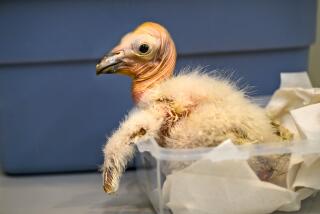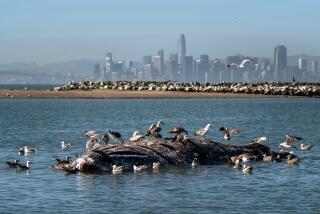Bird Rescue Gives Pelican Chicks a Second Chance
- Share via
CORDELIA, Calif. — Miles from the shores where they usually soar, 10 baby brown pelicans lounge by a pool in a roomy cage, large buckets of fish there for the taking.
Just days ago, these birds could not feed themselves.
Starving baby pelicans -- emaciated, cold and too weak to fly -- are washing up on California beaches in disturbing numbers this spring, say wildlife rescuers and state officials.
The underfed pelicans have stirred concerns over this endangered species, which has recently shown signs of recovery. Ironically, biologists say, that recovery also could be the source of the problem.
The International Bird Rescue Research Center in Fairfield, about 50 miles northeast of San Francisco, has taken in almost two dozen pelicans this month.
Jay Holcomb, the center’s executive director, said most came ashore near Santa Cruz and Monterey. All are from 2 to 4 months old.
The center’s sister facility in San Pedro has cared for more than 50 Southern California birds since late May.
“We have an unusually high number in rehab this year,” Holcomb said.
Several dead birds tested by the California Department of Fish and Game turned up with empty stomachs, said Hannah Nevins, a seabird biologist with the department. No evidence of toxins or infectious diseases was found.
A successful breeding season this spring made the competition for food among the pelicans more intense, Nevins said. Young pelicans fresh from the nest face steep odds against more experienced adults in the hunt for food.
“You see all these young birds trying to make it on their own,” she said.
More research is needed to see whether the starving birds also indicate a shortage of the sardines, anchovies, and other schooling fish on which pelicans feed, Nevins said.
To stabilize the starving pelicans arriving in Fairfield, rehabilitation workers hook them up to intravenous fluids. The birds then move on to liquid food tubed directly into their stomachs before being released to the cages outside.
“Some of the birds are so weak you cannot give them whole fish,” said Megan Prelinger, a wildlife rehabilitation specialist at the Rescue Research Center.
Pelicans can eat up to 5 pounds of fish per day once they move back to solid food. Nursing a bird back to health, Prelinger said, takes about 10 days and $200.
Of the more than 20 birds the Rescue Research Center has helped, two have died from starvation. Three others have recovered fully and were released back into the wild along San Francisco Bay.
“This is their second chance,” Holcomb said. “We want them to be perfect so they have a chance of making it.”
California brown pelican populations began to rebound after the federal government banned the pesticide DDT in 1972. Pelicans nested on Prince Island near the Channel Islands this year for the first time since 1939, evidence the bird is returning to its historical breeding colonies.
Scientists estimate 7,000 breeding pairs have nested in California in recent years, up from a complete collapse in the early 1970s.
The U.S. Fish and Wildlife Service is considering whether to remove the California brown pelican from the federal endangered species list.
More to Read
Sign up for Essential California
The most important California stories and recommendations in your inbox every morning.
You may occasionally receive promotional content from the Los Angeles Times.










